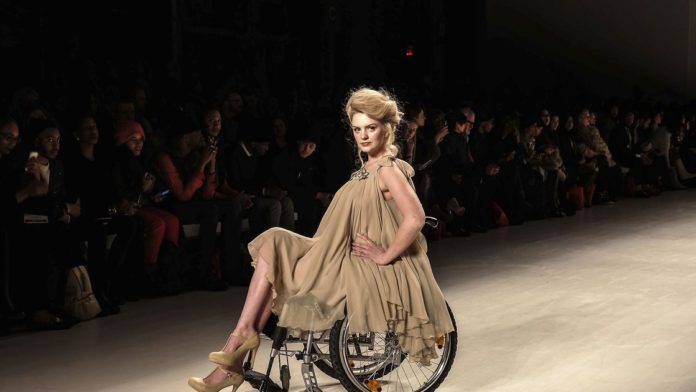At a panel by Academy of Art University in early 2018, moderated by the School of Fashion Assistant Director of Fashion Styling, Flore Morton, students and other attendees were challenged to consider two questions:
- Is good design always designing for the same few?
- Or is it designing for people in many different groups, including people with disabilities?
The panel sought to challenge students and other participants to redefine their concept of “good design,” and include people whose disabilities present difficulties to the types and styles of clothing they can wear.
The Challenges of Inclusive Design
For most people, clothing challenges never come to mind, but for those who have various disabilities, they are everyday struggles. People with full mobility, for example, hardly notice how they automatically—almost subconsciously—adjust theirclothing for it to hang properly. The same cannot be said, however, for those who spend most of the time sitting in a wheelchair, or needing a walking assistance that requires both hands to manipulate. Even simple design elements, such as studs or zippers,can cause sores from constantly rubbing against the skin because they stay seated most of the time.
Participants heard ideas from panelists concerning these and other challenges to inclusive fashion design, as well as how some advances are being made in this area.
The afternoon was filled with an insightful discussion that covered topics such as how designers can integrate elements that serve the needs of disabled individuals into their creations; the components of good universal design; and the current state of the fashion industry when it comes to designing for those with disabilities and viewing them as legitimate customers.
“These may not be the sexiest projects or get worn by an A-lister,” said panelist Beau Oyler, “but they are meaningful projects for meaningful individuals. As designers, part of our responsibility is to seek out and accept opportunities to design these types of products.”
Challenges from Inclusive Fashion Design Panelists
The guest panelists for this discussion all deal with some form of disability each day of their lives, and all of them are heavily invested in inclusive fashion design, from both necessity and passion.
Stephanie Thomas
Academy of Art University alumnus Stephanie Thomas (MFA 2013, Fashion Journalism) was born missing a thumb and several toes. Doctors said Stephanie would never walk properly or dance. She proved them all wrong, not only by walking, but also by dancing and cheering as a professional cheerleader for the Chicago Bulls. Stephanie was also the first in her family to go to college, and now holds a BA in Business Administration & Marketing from Sullivan University, an MA in Communications from Regent University, and an MA in Fashion Journalism from the Academy. She also teaches as an adjunct professor.
Stephanie started her own company, called Cur8able. Described as a “disability fashion lifestyle hub,” her company “provides an inspirational and empowering space for those with disabilities or physical challenges” and promotes ‘adaptable fashion‘ for those living with disabilities.
“People with disabilities are people first,” said Stephanie. “Everyone with disabilities defines themselves differently—that’s part of being an individual.”
Stephanie continued that thought by pointing out that one in five people in the world have a disability. This group is constantly growing due to accidents or illness.
Beau Oyler
Since graduating from the Academy School of Industrial Design in 2005, Beau Oyler founded Oakland-based Enlisted Design and co-founded Urbio, a design and manufacturing company specializing in organizational solutions for small-space living. He’s also accumulated a number of prestigious awards. Beau suffers from hemophilia, a deadly bleeding disorder.
“I think a lot of people are roaming this great earth with disabilities we don’t see,” said Beau. “When I start the design process, I dive deep into really understanding who’s going to use this product, how they’re going to use it and how we can design it in a way that’s going to be a delight for them to use.”
He added that new technology such as 3-D printing has allowed radical changes in the fashion design field, giving the ability to customize products and cater to disabled customers.
“We can design the general form factor of a product and have certain parts that are customizable,” Beau explained. “They can be customized to your fashion, your body type and your ability. It’s really about being able to go from mass production to small production.”
Chelsea Werner
Chelsea Werner, a young woman with Down syndrome, and her mother, Lisa Werner, also joined the panel. Chelsea won the Special Olympic U. S. National Championships in gymnastics four times and recently began a career in modeling. She’s walked the runway at New York Fashion Week and appeared in an H&M campaign.
When a student asked Stephanie Thomas if she felt there was a need for more like-minded designers, she said, “Yes, yes, and yes. We need more designers and a lot of designers are just, quite frankly, afraid of it.”
Lisa Werner agreed when panelist Stephanie Warner emphasized the need for more designers who are willing to delve into inclusive design. She shared that her daughter Chelsea wants to wear high heels and other age-appropriate styles, but because of her disability and small size, she’s often forced to buy children’s clothing. When she wanted to wear high heels in a fashion show, Lisa had to order a custom-made pair. Her shoe size: two.
“I think the public wants to see a lot more diversity in fashion,” said Lisa. “Once more designers become willing to take a chance and see how people respond, I think it’s going to happen more and more.”
People with disabilities and others just like you who desire a career in fashion or the arts have found the means to meet those challenges at Academy of Art University. Since 1929, students have gone on to contribute to the arts and industry while bettering the world around them.
Related: Academy of Art University Exemplifies the Strength of Arts Education in a STEM-Driven World












